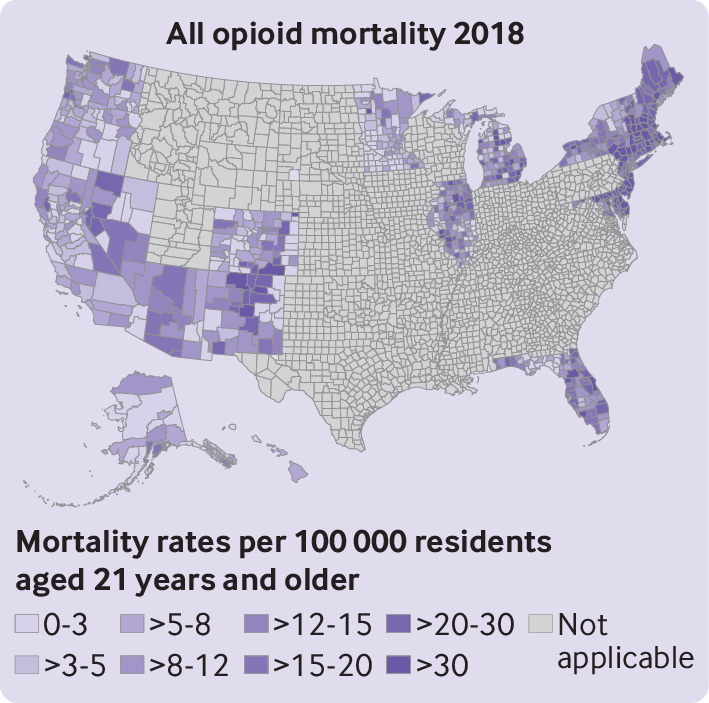TL;DR
- A new study by researchers at Yale and UC Davis shows opioid-related deaths were reduced in counties with more cannabis dispensaries between 2014-2018.
- Opioid abuse in the US is high. Nearly 47,000 people died from opioid overdose in 2018. Deaths from illegal Fentanyl use make up two-thirds of this total.
- The study examined 812 US counties with licensed medical and recreational cannabis dispensary storefronts across 23 states (incl. D.C.).
- Counties with one dispensary saw opioid deaths slashed by 17%. Counties with two saw a 21% reduction. Counties with three saw a further 8.5% reduction.
- The authors note this study is observational and doesn’t account for cause. They also state cannabis isn’t being glorified and does still pose public health risks despite being less addictive than opioids.
A recent study published by BMJ shows counties across the US with more cannabis dispensaries (medical and recreational) experienced fewer opioid-related deaths compared to other US counties between 2014-2018.

The study, conducted by researchers at Yale and the University of California, Davis, is the first to look into the relationship between cannabis dispensaries and opioid-related fatalities at the county level.
Opioids (also known as narcotics) are a class of drugs typically prescribed by doctors and medical professionals to treat chronic and persistent pain. Some opioids are prescribed for mild-to-moderate pain, while others for more severe pain. Within this class, you’ll find commonly prescribed opioids such as oxycodone, fentanyl, and morphine, as well as illegal heroin.
According to the most recent data from the Center for Disease Control (CDC), nearly 47,000 people in the US died from an opioid overdose in 2018. A further 10 million are thought to be abusing prescription opioids. The most commonly abused prescription opioids are Oxycodone, Methadone, and Hydrocodone.

Illegally-obtained Fentanyl, a highly-potent synthetic opioid medicinally used to combat advanced cancer pain, is also a major problem in the US. Many black market Fentanyl is imported from overseas and often carries heroin or cocaine to enhance its euphoric effects.
More than 46,000 people died from illegal Fentanyl use, which accounts for two-thirds of the overall opioid-related deaths in 2018.
The connection between cannabis use and opioid misuse reduction (is there one?)

Out of a total of 3,000, researchers at Yale and UC Davis examined 812 individual counties across 23 states (incl. District of Columbia) with legal and licensed recreational or medical cannabis dispensaries by the end of 2017.
No centralized federal database or intrastate database of cannabis dispensaries exists. Medical and recreational marijuana is still very much illegal in the US. The team relied on Weedmaps.com to compile county-level data on cannabis dispensaries and combined it with CDC and US census data.
The study reveals areas with one storefront cannabis dispensary experienced an approximate 17% reduction in opioid-related fatalities, while areas with an increase from one to saw an estimated 21% reduction. The rate fell by an additional 8.5% if the area had a cannabis third dispensary.
Unfortunately, the results of this study are purely observational and don’t conclusively determine the cause, though the link between the existence of cannabis dispensaries and the reduction in opioid abuse and fatalities is promising.
“While the associations documented cannot be assumed to be causal, they suggest a potential relationship between increased prevalence of medical and recreational cannabis dispensaries and reduced opioid-related mortality rates”, noted Greta Hsu, UC Davis professor and lead study author.
However, the authors make it clear this isn’t a rally-cry for legislators and policymakers to suddenly legalize medical and recreational cannabis. The consumption of cannabis carries its own public health and safety risks despite being less addictive than opioids. More research needs to be conducted before any rash conclusions are to be made.
What we know about marijuana and opioid abuse

Medical marijuana for opioid dependency, abuse, and addiction is currently being studied as a promising therapeutic avenue.
A recent Canadian research effort suggests medical marijuana can help alleviate opioid dependency and addiction, as well as significantly improve a patient’s quality of life. Researchers used a survey-based method of collecting data from 1,145 patients across 21 Canadian clinics.
Over a six month period, medical marijuana reduced opioid use and dependency from 28% to 11%. Daily opioid dosage also dropped from 152-milligram morphine equivalent (MME) to 32.2 MME (78% reduction). Users also reported an increase in physical and mental quality of life.
The authors of the study note how promising the results are and could lead to cannabis combating the opioid crisis.
“The high rate of cannabis use for chronic pain and the subsequent reductions in opioid use suggest that cannabis may play a harm-reduction role in the opioid overdose crisis, potentially improving the quality of life of patients and overall public health.”


